
Eufaula is the largest city in Barbour County, Alabama, United States. As of the 2010 census the city's population was 13,137.
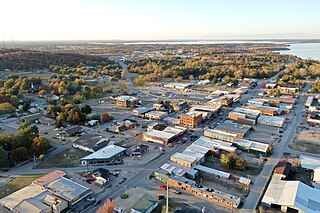
Eufaula is a city and county seat of McIntosh County, Oklahoma, United States. The population was 2,813 at the 2010 census, an increase of 6.6 percent from 2,639 in 2000. Eufaula is in the southern part of the county, 30 miles (48 km) north of McAlester and 32 miles (51 km) south of Muskogee.

The Duke Ellington House is a historic residence at 935 St. Nicholas Avenue, in Manhattan, New York City. Apartment 4A in this apartment house was the home of Duke Ellington (1899-1974), the noted African American composer and jazz pianist, from 1939 through 1961. It was listed on the National Register of Historic Places as a National Historic Landmark in 1976.

Gaineswood is a plantation house in Demopolis, Alabama, United States. It is the grandest plantation house ever built in Marengo County and is one of the most significant remaining examples of Greek Revival architecture in Alabama.

The American Bank Note Company Building is a five-story building at 70 Broad Street in the Financial District of Manhattan in New York City. The building was designed by architects Kirby, Petit & Green in the neo-classical style, and contains almost 20,000 square feet (1,900 m2) of space, with offices and residences on the upper floors. The exterior consists of a main facade on Broad Street with two columns, as well as side facades with pilasters on Beaver and Marketfield Streets.

The Dr. William Barrow Mansion is located at 83 Wayne Street between Barrow Street and Jersey Avenue in Downtown Jersey City, Hudson County, New Jersey, United States. The mansion was added to the National Register of Historic Places on May 2, 1977, and is located within the Van Vorst Park Historic District, which itself was dedicated on March 5, 1980, and is roughly bounded by Railroad Avenue, and Henderson, Grand, Bright, and Monmouth Streets.
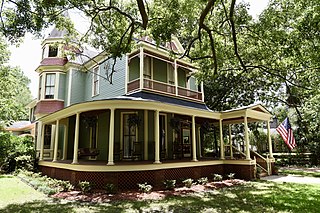
Paradise Park Historic District is located in Thomasville, Georgia. It was listed on the National Register of Historic Places 1984 with an increase in 2002. It consists of Thomasville's Paradise Park, and properties including 15 contributing buildings and one non-contributing building.

The Alverson-Copeland House is a historic house located at 1612 Rochester Street in Lima, Livingston County, New York.
Henry W. Livingston House, also known as "The Hill", is a historic home located at Livingston in Columbia County, New York. It was built in 1803 and is a massive, two-story brick dwelling coated in stucco. It has a three-bay central block with wings that terminate in octagons. The central block features curved bays and a two-story portico with four Ionic order columns and cut stone stylobate. There are also one-story curved porches with smaller Ionic columns that connect the octagons of wings to the central block. It was built by Henry W. Livingston (1768-1810).
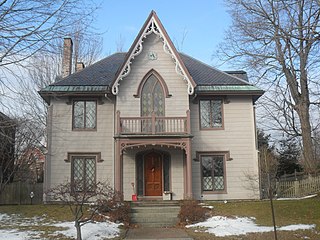
The Gothic House, also known as the John J. Brown House, is an historic house at 387 Spring Street in Portland, Maine. Built in 1845, it is one of Maine's finest and earliest known examples of Gothic Revival architecture. Although it is virtually unaltered, it was moved down Spring Street in 1971 to avoid demolition. It was listed on the National Register of Historic Places in 1974.
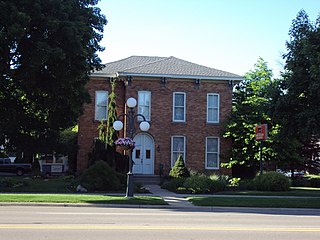
The Dr. Samuel Catlin House is a former residence located at 213 East Chicago Boulevard (M-50) in downtown Tecumseh, Michigan, United States. It was listed as a Michigan State Historic Site and added to the National Register of Historic Places on August 13, 1986. It is located across the street from Saint Elizabeth's Church and down the street from the Tecumseh Downtown Historic District.
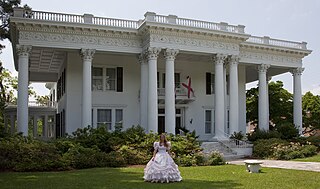
The Shorter Mansion is a Classical Revival-style historic house museum in Eufaula, Alabama. The two-story masonry structure was built in 1884 by Eli Sims Shorter II and his wife, Wileyna Lamar Shorter, but it burned in 1900. The house as seen today was built in 1906 and was designed by architect Curran R. Ellis of Macon, Georgia. Eli Sims Shorter died in 1908, but his wife resided in the house until 1927, when it was passed to their daughter, Fannie Shorter Upshaw. It was in turn inherited by Upshaw's daughter, Wileyna S. Kennedy, in 1959.

Horace Jayne House (1895) is an architecturally significant building designed by architect Frank Furness in Philadelphia, Pennsylvania. It is located at the southwest corner of 19th and Delancey Streets, about a block south of Rittenhouse Square.
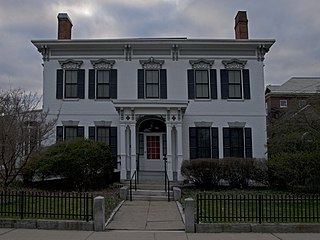
The President's House of Keene State College, formerly the Catherine Fiske Seminary For Young Ladies, is a historic house at 251 Main Street in Keene, New Hampshire. Built in 1805 and restyled in the late 19th century, it is one of Keene's oldest brick residences, and now serves as the official residence of its president. The house was listed on the National Register of Historic Places in 1976.

The Capt. Thomas Morse Farm is a historic farmhouse on Old Marlborough Road in Dublin, New Hampshire. It is a small 1+1⁄2-story two-room cottage, similar to other early period Cape style farmhouses in the town and probably built in the late 18th century by one of the town's first settlers. Now a clubhouse for the Dublin Lake Golf Club, it is one of the few buildings from that period to survive. The house was listed on the National Register of Historic Places in 1983. It appears to have been torn down and replaced by a more modern structure.

The Dudley House, also known as the Perry-Dudley House, is a historic house at 14 Front Street in Exeter, New Hampshire. Built about 1805, it is a prominent local example of Federal architecture, further notable for its occupation by two of the town's leading 19th-century doctors. The house was listed on the National Register of Historic Places in 1971. It now houses professional offices.

The Gehring Clinic is a historic house and medical facility at the south end of Broad Street Historic District in Bethel, Maine. Built in 1896 for Doctor John George Gehring, it is a fine local example of Queen Anne architecture. It is recognized, however, for its association with Gehring, a nationally known psychotherapist who was an early proponent of the use of hypnosis to treat nervous disorders. Gehring opened his large home as a rest home for those who traveled to Bethel to receive his treatment. The property was listed on the National Register of Historic Places in 1976.

The Cato House was built in 1858 for Lewis Llewellen Cato in Eufaula, Alabama. Cato was an attorney and a prominent secessionist. The one-story frame house was built by slave labor. The front of the house features a broad porch with a central pediment over the double front doors. A central hall leads to a dining room in the center of the house, flanked by parlors and the master bedroom. Another dining room and a bedroom are to the rear. The attic in the shallow-pitched pyramidal roof is surmounted by a small pavilion, itself surrounded by a small porch.
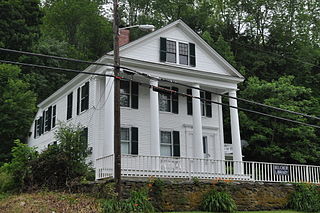
The Belcher Memorial Library is a small public library serving the village of Gaysville in Stockbridge, Vermont. It is located in the Daniel Gay House, an 1835 Greek Revival house built by Daniel Gay, a mill owner and namesake of the community. The building, one of the few to survive the 1927 flooding that destroyed most of the village, was listed on the National Register of Historic Places in 1978.
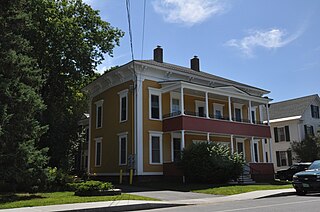
The Shearer and Corser Double House is a historic house at 592 Summer Street in St. Johnsbury, Vermont. Built as a school about 1854, it has had a history of varied uses and prominent local owners, and has high quality Colonial Revival and Italianate features. It was listed on the National Register of Historic Places in 1994.






















